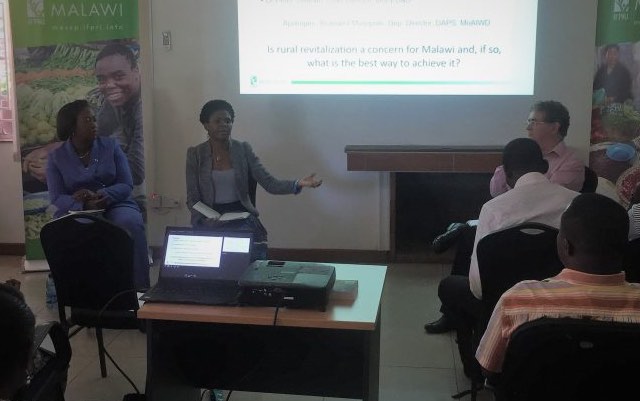Rural people around the world continue to struggle with food insecurity, persistent poverty and inequality, and environmental degradation. IFPRI’s 2019 Global Food Policy Report (GFPR) outlines a strategy for rural revitalization to transform rural areas into vibrant and healthy places to live, work and raise families. The April 3 IFPRI Malawi GFPR launch in Lilongwe explored the potential for Malawi’s own rural transformation.
An audience of representatives from international organizations, academia, research institutes, development partners, the private sector, civil society and government watched recorded speeches and discussions from the March 27 global launch in Washington, followed by a live panel discussion. Panelists included Grace Kumchulesi, an IFPRI consultant ; Betty Chinyamunyamu, CEO of the National Smallholder Farmers’ Association of Malawi (NASFAM); and IFPRI Malawi Program Leader Bob Baulch. They addressed the question: “Is rual revitalization a concern for Malawi and, if, so, what is the best way to achieve it?”
Baulch began by outlining some key facts that captured the country’s challenges: Malawi has one of the youngest population structures in the world, with 51% under 18; 84% of its 17.6 million people live in rural areas, according to the 2018 census. The poverty rate for rural areas is 60%, vs. 18% for urban areas, according to the 4th Integrated Household Survey (IHS4) of 2016/17, and 24% of the rural community is considered as ultra-poor. The Demographic Health Survey 2015–2016 (DHS15–16) found stunting rates in rural areas were 39%, compared to 25% in urban areas. The United Nations Development Programme’s Human Development Index (HDI) ranks Malawi at 171 out of 189 countries and territories.
Malawi’s government recognizes the urgent need for rural revitalization, Kumchulesi said, and is addressing the issue through its Decentralization Policy and the Malawi Growth and Development Strategy (MGDS) III . Rural revitalization, she stressed, depends on achieving all 17 Sustainable Development Goals (SDGs) in the 2030 agenda. “Malawi needs to take an integrated, multi-sectoral approach, fully committing its investments in all sectors of development as identified by the MGDS III,” she said. “Good governance and strong leadership are key to greater accountability from all stakeholders involved in the cross-sectoral efforts around rural revitalization.” Rapid population growth is one of the most urgent issues Malawi must address, she said.
Access to electricity is another big problem, Baulch said. Only 3% of Malawi’s rural population has it, vs. 42% of urban residents and 11% overall, meaning rural residents must rely on traditional sources of energy such as wood. This “is a challenge, if we talk about rural revitalization,” he said, as it leads to deforestation and slows economic development.
Malawi depends on agriculture as an economic lifeline, Chinyamunyamu said. Agricultural transformation must start with smallholder commercial agriculture, including increasing productivity, improving processing and adding value along the supply chain, and diversifying crops and production.
“But with the current infrastructure, it is almost impossible” to foster growth and productivity in Malawi, she said. In addition to electricity, better infrastructure (such as roads and bridges) and greater market competition are needed to establish a more efficient transport network. Quality management and better warehousing can also increase rural productivity. Rural industry should also receive incentives, such as the establishment of special economic zones, Chinyamunyamu said.
“Rural revitalization depends on symbiotic relationships, not parasitic ones,” she said. This depends on inclusive business models that build on rural-urban linkages and win-win options for both.
Women play key roles in rural agriculture, she added, and development programs focusing on women’s empowerment are a key element of rural revitalization. Finally, she said, building resilience to climate impacts, including strategies for adaptation and mitigation, are crucial in countries like Malawi, where agriculture is the main source of livelihoods.
Rural revitalization is not a new term for Malawi, both Kumchulesi and Chinyamunyamu noted. As the 2019 GFPR observes, rural revitalization is a concern for nearly all countries, but there is no “one fits all” approach. There are five building blocks to rural revitalization: creating farm and non-farm rural employment opportunities; achieving gender equality; addressing environmental challenges; improving access to energy; and investing in good governance. Cultivating synergies between these elements is essential to generate rapid and broad growth in Malawi’s rural areas and elsewhere in the world.
Sandra Fröbe-Kaltenbach is a Communications Specialist with IFPRI Malawi. This post also appears on the IFPRI Malawi blog.







